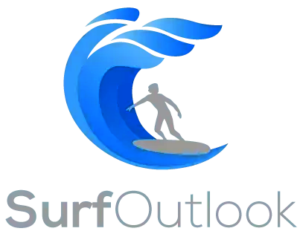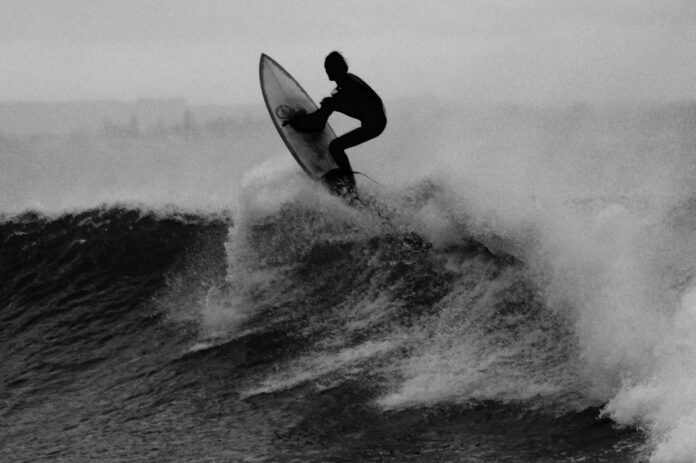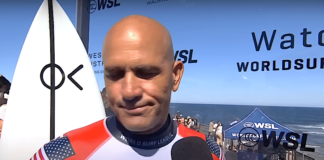For those adventurous souls who find solace and purpose in search of the next big swell, surfing is one of life’s greatest joys. But for many surfers, the love of the sport extends even deeper — for surfer-turned-filmmaker Logan Dulien, surfing effectively saved his life.
Dulien refers to surfing as the “healthiest addiction in the world.” He claims that the saltwater, and the essential Vitamin D from the sun, helped him heal from his opioid dependency. The SURFER award-nominated director (for 2017’s “Snapt3”) struggled with addiction for much of his adult life.
According to Dulien, his use of opiates eventually went well beyond physical pain relief. He used pills to numb his emotions in the same vein as his friend and colleague Andy Irons, whose untimely 2010 death from an opioid overdose sent shock waves through the professional surfing community. Irons was just 32 and fresh off a first-place finish at the Billabong Pro Teahupoo.
Following Irons’ death, the World Surf League (then known as the Association of Surfing Professionals) introduced drug testing policies for its athletes, but the damage was already done. And despite the inherent dangers of prescription opioids, they remain the go-to method of pain relief for countless athletes in nearly every sport.
Yet opioids are far from the last word in pain management, and holistic health has found an unlikely home in the surfing community. Prominent athletes such as Dulien are working to cultivate greater awareness of the dangers of opioids, and the myriad alternative, natural remedies that exist.

Opioid Misuse in the Sports World
Like many opioid addicts, Dulien’s relationship with the drugs began with prescribed pain management following an injury. It’s a story that, for many surfers, is easy to relate to — every time you take to the waves, you put yourself in harms’ way, and the sobering reality is that accidents can (and will) happen to the best of us.
Some of the most common surfing injuries include repetitive strains, lacerations, and head injuries. In the event of a surfing accident that results in injury, your healthcare provider may prescribe opioids to manage pain. Opioids are also commonly prescribed to treat chronic pain, whether stemming from injury or the simple wear-and-tear your body experiences after years of surfing.
Although opiate-derived painkillers are indeed effective in pain management, they are also highly addictive. Along with Dulien and Irons, many professional athletes have fallen under the spell of opioids, including legendary golfer Tiger Woods, who has been extremely candid about his struggles with addiction.

America’s Opioid Epidemic by the Numbers
Opioid misuse isn’t solely the domain of pros, however. In the world of surfing, even groms are at risk of developing an opioid addiction. A 2013 study involving young participants of high-injury sports found that those athletes were twice as likely to misuse prescription opioids than non-athletes of the same age. Unfortunately, the prevalence of what researchers refer to as the nonmedical use of prescription opioids (NMUPO) has only gotten worse since that time. In fact, the Centers for Disease Control and Prevention (CDC) reports that 128 Americans die from an opioid overdose every day.
The emotional numbness described by Dulien can, in many ways, be viewed as the true crux of the opioid epidemic. Surfing, especially at the competitive level, is stressful, taking a toll on both your body and mind. Injuries only serve to compound those stressors, especially when they are accompanied by hefty medical bills.
For athletes, excessive medical debt is a grim reality that only serves to fuel a developing addiction. The good news is that injured athletes may be able to reduce some of that financial stress by seeking medical bill forgiveness. By negotiating payment plans and engaging in active communication with your medical providers, you may see drastically reduced medical bills and the stress that often accompanies those bills.
Seeking Healthy Pain Relief Alternatives
Of course, open communication with your healthcare provider is crucial in terms of combating opioid addiction. In the event of a surfing injury, you can opt to seek out alternative methods of pain management, rather than turning to prescription opioids.
Keep in mind that pain relief is often a highly personal endeavor, and what works for one athlete may not be the best choice for you. Some athletes turn to homeopathic and herbal remedies for pain relief, such as kratom, a flowering plant native to Southeast Asia. More research is needed in the true efficacy of kratom in regards to pain management, but results are promising.
But medications, whether prescription opioids or herbal remedies, may not even be necessary for pain relief. Like Logan Dulien, you may find that surfing and/or a regular exercise regimen brings you effective pain relief. Science even backs up the idea of exercise as a means of fighting addiction, as it can help you focus on something besides the cravings. In this way, surfing has the potential to save your life.

Key Takeaways
Pain and injury are just part of the territory for surfers of every skill level. But addiction doesn’t have to be. When injured, surfers from all walks of life can honor the legacy of the late Andy Irons by eschewing prescription opioids in favor of natural remedies, or even via the healing power of surfing itself.





